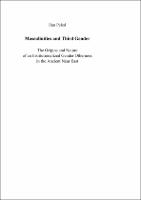Masculinities and Third Gender
The Origins and Nature of an Institutionalized Gender Otherness in the Ancient Near East (Volume 9)
Author(s)
Peled, Ilan
Collection
Knowledge Unlatched (KU)Number
105321Language
GermanAbstract
The aim of this book is to track a distinct human phenomenon in the history of the ancient Near East: persons who were born males, but under various social and historical circumstances their masculine identity was considered to be ambiguous. On the basis of this, these persons can be classified as belonging to a third gender They bore specific titles, and were engaged in cult or palace administration. The contexts of their documentation occasionally depict them as possessing or exhibiting traits that were uncharacteristic of the standard social expectations of men in Mesopotamia. The terms that describe these persons were grouped in numerous lexical lists, which supply us with the frame and boundaries of the present research. To a lesser extent, the grouping of these persons is apparent in narrative and literary compositions. The most notable of these titles were gala / kalû, assinnu, kurgarrû and lú-sag / ša rēši. Other similar titles that were documented less frequently were kulu'u, girseqû, tīru, SAG-UR-SAG, pilpilû, nāš pilaqqi, sinnišānu and parû. Their sexual and gender ambiguity was realized in numerous and diverse manners. Occasionally, it bore a clear physiological form, in the shape of castration; sometimes its attributes were external, such as cross-dressing; In other cases, it became apparent through typically feminine behavioral patterns, such as dancing, singing or lamenting. Last but not least, lack of procreativity constituted another form of gender ambiguity, as it contradicted one of the most important gender functionalities of people in the ancient Near East: the siring of offspring. Hence, the common denominator of all these figures appears to have been flawed manliness. Effeminacy was not necessarily the key factor in this case, as some of these figures seem to have been rather masculine. It was sufficient that these persons deviated enough from the customary model of ancient Near Eastern masculinity, in order to be considered as part of this third gender class. The concepts of social “otherness” are essential for demarcating social borders, which, in turn, define patterns of normative social conduct. The present research demonstrated that this human phenomenon of a third gender in the ancient Near East involved mainly the matter of social definitions. Social identity is defined by its limitations: where it begins and ends, and what exists beyond it. The strange, the extreme and the bizarre signify what common, hegemonic, people are not, and therefore mark who common, hegemonic, people actually are. These boundaries are constructed by using social mechanisms of norms and prohibitions. In this sense, the third gender figures were socially constructed, and served social needs of defining norms of conformity.
Keywords
History; Asia; Social Science; Gender StudiesDOI
https://doi.org/10.25162/9783515130974ISBN
9783868351958Publisher
Ugarit VerlagPublisher website
https://ugarit-verlag.com/Publication date and place
2016Grantor
Imprint
Ugarit VerlagClassification
Asian history
Gender studies, gender groups


 Download
Download